Staying Grounded While Green: The Best Eco-Friendly Yoga Mats
11 min read · Last updated December 19, 2021
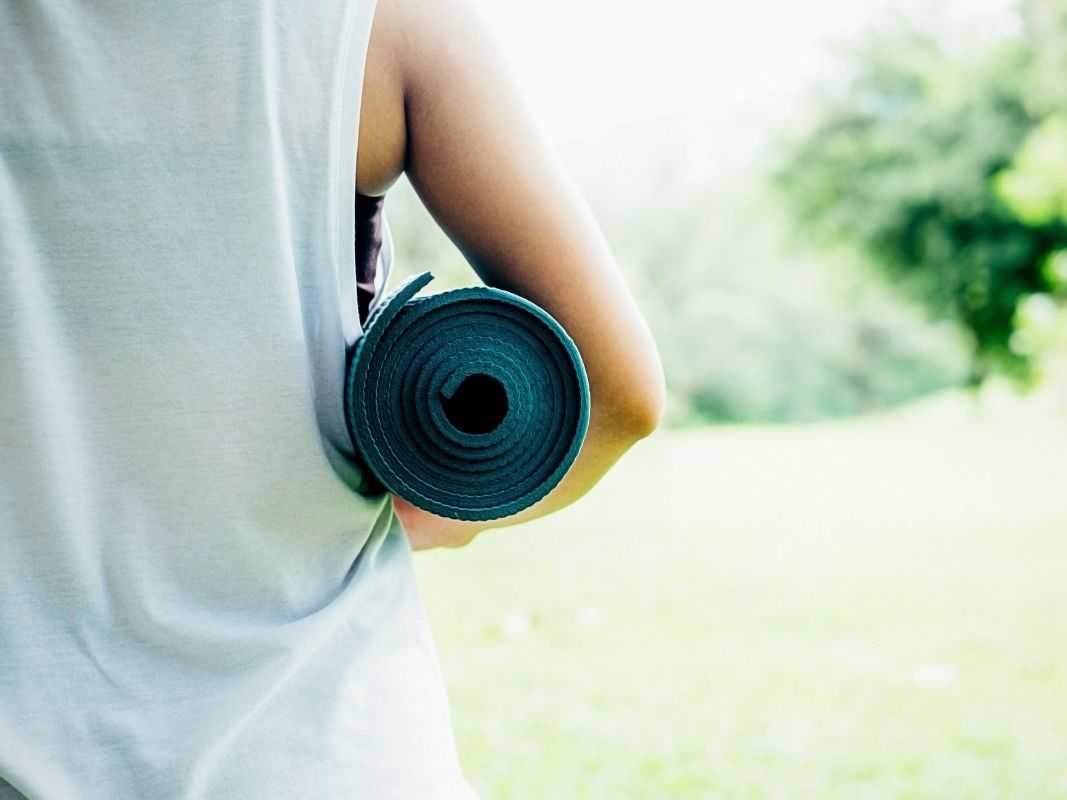
When it comes to fitness and wellness, there is no shortage of activities to try out. Whether you are the type who wants to shed fat or incoordination, improve physical strength or cardiovascular function, gain muscle tone or mental clarity, there’s bound to be a couple of types of exercise or joyful movement that will click with you.
For many people, yoga ends up at the top of their list since it’s more relaxed and low-impact but still fantastic at promoting flexibility, stamina, and tone. Incorporating a yoga practice into your daily routine can help lower stress, improve flexibilty, and increase your overall sense of well being.
There’s just one problem with this; it's not always environmentally friendly thanks to yoga’s various props and products. And yoga mats are some of the worst offenders.
Read along to learn why this is, what to look for in a more sustainable yoga mat, and discover some of the better options on the market today that can take your practice from haphazardly harmful to groundedly green.
Some of the links in this post are affiliate links. If you click on the link and purchase the item, I may receive an affiliate commission at no extra cost to you. All opinions remain my own.
Article Contents
The Problems with A Typical Yoga Mat
Yoga – at least, the northern Indian tradition of yore – is about conscious change, sacrificing the ego to exist in a more enlightened manner. It’s about recognizing all is connected; every person and aspect of the planet around us a part of us as we are them.
A side effect of this is living in a more sustainable, kind, and environmentally-conscious way as practitioners understand that hurting the planet is just another way of hurting themselves.
However, our modern take on yoga appears to have missed the original movement’s memo. Nowadays, the yoga we all know and love can be called anything but sustainable. The fault of this primarily lies in the colorful, cushy mats that keep us comfortable as we reach, stretch, bend, and breathe our way to better physical and mental health.
This is because most conventional options available for purchase are crafted from a host of non-eco-friendly materials, including a material called polyvinyl chloride, or PVC for short.
Why most yoga mats are made from PVC
PVC is a mass-produced and widely-used synthetic plastic polymer that was accidentally invented in 1872 after vinyl chloride gas was exposed to sunlight. Cheap to make and adaptable, since it can either be kept in its rigid state or made flexible, today it’s used in everything from plumbing to clothing – and yes, even yoga mats.
Unfortunately, this material isn’t just affordable and versatile. It’s also incredibly harmful to both our planet and our health, widely regarded by experts as one of the most toxic plastics within current use.
PVC's detrimental effects
And it's not just because of what happens when PVC is inevitably discarded after it outlives its usefulness. According to places such as the Center for Health, Environment and Justice, PVC releases hazardous waste byproducts in both its production and as it breaks down in landfills or (even worse) in a fire, if foolishly incinerated.
Released dioxins, phthalates, lead, mercury, and other potentially toxic chemicals can all then leak into groundwater, make their way into our water supply, or evaporate into the air, harming the world we live in and, ultimately, us.
The packaging and labor practices that are bound up in PVC-based yoga mats also bring up their own environmental (and ethical) challenges. The heavy presence of wasteful non-recycled cardboard and plastic packaging are two of the major contributing factors here, polluting our oceans, adding to deforestation, and persisting long after their intended mission is complete.
Add in the fact that most means of production rely on a great deal of oil consumption and energy-intensive processes, and ecological dangers are further compounded.
However, besides being a large source of environmental issues in both creation and disintegration, there are concerns about PVC being a health hazard during its lifespan. With additives including phthalates, organotins, and cadmium, some worry that even more casual exposure from flooring, care products, yoga mats, and such could affect the central nervous system, cause birth defects/pregnancy problems, and elevate the risk of certain cancers or harm the reproductive system.
Long-term human studies have been few and far between to truly cement this concern as fully supported. Still, there’s enough associated science to make opting for materials other than PVC a safe precaution regardless.
What to Look for in a Greener Mat
After looking at all the available information, it’s evident that most traditional yoga mats aren’t the best choice for aspiring yogis to purchase when starting up a new yoga practice. Bad for Mother Earth and maybe even our health, these standard yoga mats are better off left on store shelves than taking up room with our other workout equipment.
What exactly are you supposed to do, then? There are a couple of answers to this query.
The greenest option: go mat free
The first is pretty obvious: just don’t use a yoga mat. They may make your practice more comfortable and a little safer since they can reduce potential slippage, but they’re not actually essential for most people – something especially true if you’re doing yoga somewhere soft like on carpet or a gym cushion. Plenty of folks around the world regularly ditch the yoga mat, so it can be done if you really want your yoga session to be as eco-conscious as can be.
What if are one of those people who do need the additional cushioning and support, though? Thankfully, you’re not out of luck. A growing number of companies are dedicated to producing sustainable yoga mats that enable you to feel good about your exercise routine and your personal environmental footprint. You simply have to know what to look for while on the prowl for your next purchase. If you need a little help here, no worries.
Pay attention to materials
First and foremost, you’ll want to be on the lookout for a mat comprised of sustainable materials. Specifically, this entails turning your back on those mats with materials that require a great deal of processing or end up depleting finite resources. The best eco-friendly yoga mats are made with renewable, preferably recycled materials, and otherwise have a positive impact on communities rather than negative.
Sustainably-sourced cork, jute, cotton, wool, and other natural fibers are excellent choices that hit these marks and are capable of offering good performance all the while.
Recycled rubber is another option to consider should you not have any luck with the aforementioned materials. It’s not the ideal option as no rubber, regardless of whether it’s recycled, ethically sourced, etc., is particularly wonderful for the environment, but it remains a far better choice than the alternative.
Don't overlook packaging
Beyond considering what your yoga mat’s made out of, we’d recommend giving thought to the packaging as well. After all, eco-friendliness isn’t restricted to the product in question. It’s also everything surrounding it.
A natural cork yoga mat may be make for a more responsibly-crafted mat, but that greenness doesn’t go quite as far if it’s been taped within an inch of its life, covered in plastic, and then packed with a million of those foam peanuts surrounding it.
Getting away from every bit of packaging may not – and indeed probably won’t be – feasible, but minimizing it whenever possible is the earth-friendly thing to do.
Eco-friendly yoga mats should be packaged as minimally as possible using recycled and recyclable or compostable materials.
Support eco-friendly companies
Finally, along a similar vein of thought as the packaging, do a little research into any potential purchase’s production practices (try saying that three times fast!).
After all, sustainability isn’t just about making products in a way that avoids depleting resources; it’s just as much about reducing harm across the board.
This means the most sustainable yoga mats will be produced by ethical brands that value cruelty-free testing, fair labor, more carbon-neutral production, and community outreach.
Naturally, not every eco-friendly yoga mat will fit the bill, but it genuinely does not have to. In a world where conventional production is synonymous with intense environmental degradation, harm-reduction – not perfection – should be the end goal.
Choose What Works For Your Lifestyle
Different levels of change are okay. In other words, if you want to shell out the time, money, and energy needed to track down the greenest mat around – that’s great. But should your personal resources be more finite, even opting for the more conventional option with recycled packaging is an important and meaningful step in the right direction.
8 Great Eco-Friendly Yoga Mats
Now that you’re better informed about the problems associated with the majority of conventional yoga products and what to look for when on the hunt for a more sustainable yoga mat, you’re ready to actually get shopping! Here are eight great options that you should give more than a passing glance.
Best Natural Option: Abhinehkrafts Grass Fiber Yoga Mat

Sustainability necessitates the use of more natural materials. After all, those are often more readily renewable than their synthetic counterparts. But some are still more natural than others, and the Abhinehkrafts grass fiber yoga mat is the top of the crop.
Created by a small business and made from a handwoven mix of Darbha (a tropical grass sacred to the Vedic tradition) and organic cotton, it’s a fantastic natural mat that’s eco-friendly, non-toxic, and great for more restorative yoga sessions.
These yoga mats are basically slip free, due to the natural rubber backing. The more you sweat, the sturdier they get.
Abhinehkrafts mats work well for most styles of yoga, including hatha, vinyasa, and hot yoga. They also work well for other fitness routines or meditation sessions.
- Size: 28” x 72”
- Thickness: 4-4.5 mm
- Weight: under 3 lbs (1.3 kg)
- Notes: These mats can be used inside or outside.
Best on a Budget: Foiller Premium Natural Jute Yoga Mat
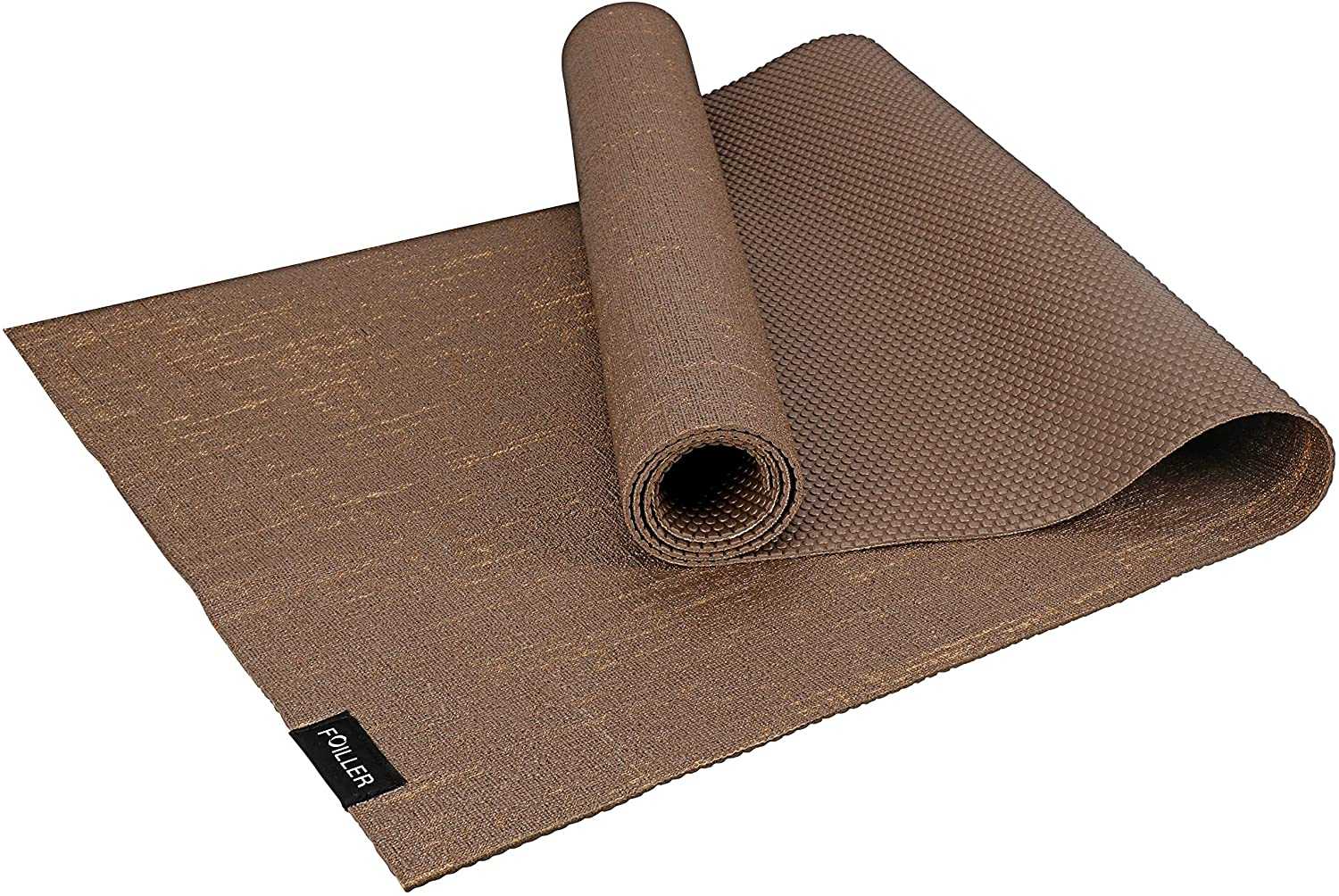
Eco-friendly is frequently code for super expensive. Wanting a product that doesn’t fall into this mold? This Foiller premium jute yoga mat might be just what you’ve been after.
With natural jute on top and TPR on the bottom, this eco-friendly natural fibre yoga mat definitely won’t break the bank.
Although this isn't the most green mat on the list, it might be the best eco-friendly yoga mat you can get for under $25.
What is TPR?
TPR stands for thermoplastic rubber. It is made from non-toxic recyclable plastics and is a great substitute for traditional rubber as it takes far less energy to produce. It is environmentally friendly and 100% recyclable.
This non-toxic yoga mat has a great balance of performance and sustainability. It is also latex free, BPA free, and 100% natural. Suitable for most workouts, this yoga mat is durable and non-slip.
Do be warned, however. The feel definitely takes a little getting used to when you’re better acquainted with PVC mats than their more natural counterparts!
- Size: 24” x 71”
- Thickness: 4mm
- Weight: 3 lbs
- Notes: Foiller stands behind this yoga mat offering a 100% satisfaction guarantee. It comes with a 365-day hassle free warranty as well as a 90-day unconditional refund.
Best for Longevity: SUGA Recycled Wetsuit Yoga Mat

SUGA recycled wetsuit mats are a bit of a strange creation but very special. Crafted in the USA from recycled wetsuits, they are light on environmental impact but heavy on quality, offering flexible comfort that’s spongey enough to slide into poses but supportive enough to handle advanced asanas.
These eco-friendly yoga mats are grippier than other yoga mats due to their unique construction. They are also super easy to clean.
Suga yoga mats are naturally antimicrobial, non-toxic, and PCV, PCB, PET, and phthalate-free.
Super durable with full-life service and replacements, a Suga yoga mat guarantees that you’ll never have to nama-stay away from your practice because of a damaged mat.
- Size: 25” x 72” or 26" x 74"
- Thickness: 5mm
- Weight: just under 5lbs
Best Non-Toxic Option: Tranquil Yogi Tranquility Cork Yoga Mat
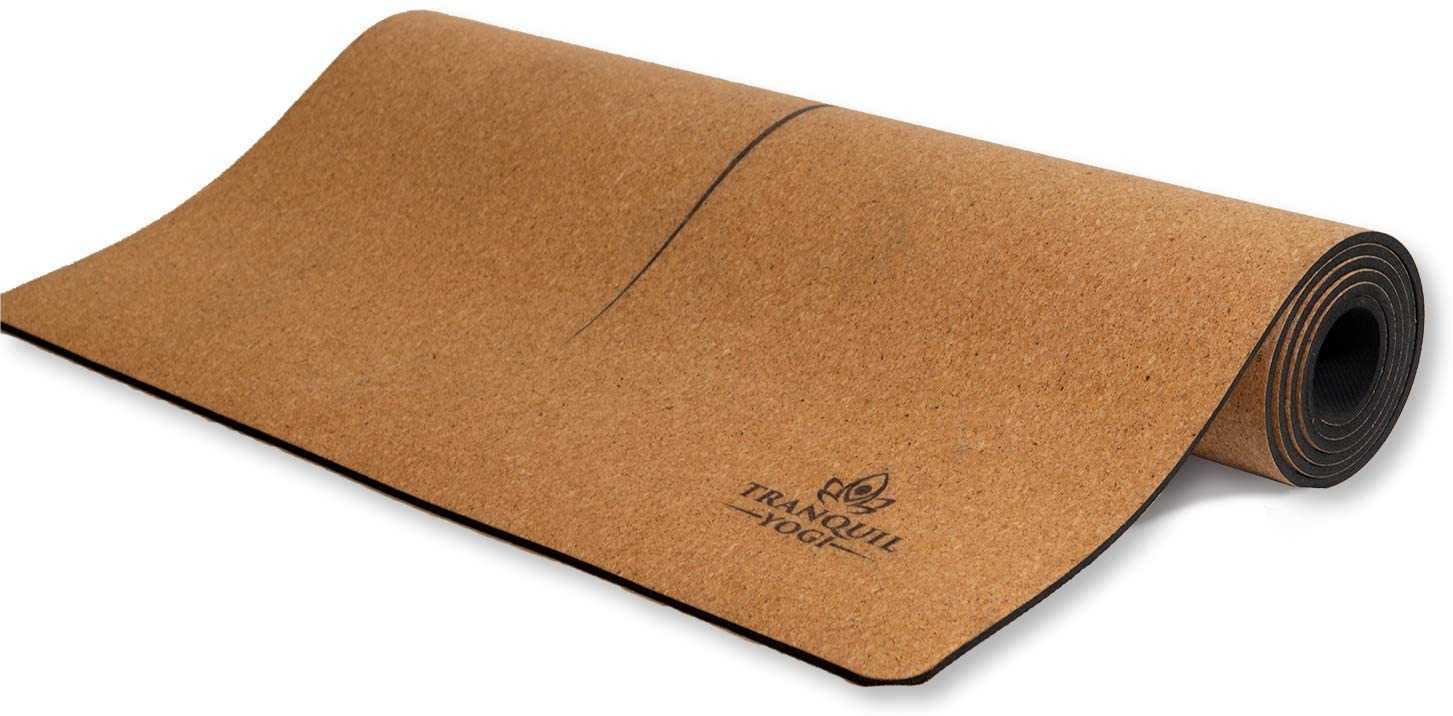
For those yogis who want to hone their skills without all the toxic materials, you’ve come to the right place. Using a special heat bonding technique, the durable cork surface affixes to the natural rubber backing without any chemicals or adhesives.
This dense, non-slip yoga mat provides comfort, functionality, and grip in every position. Non-toxic and very natural, it’s a good option for yoga enthusiasts of all ages!
All of Tranquil Yogi's cork yoga mats are made from all sustainably-harvested natural rubber and bio-degradable cork.
These eco-friendly mats come in a variety of thicknesses, so you can choose the level of padding that works best for your practice.
This high mat will provide you with comfort and stability during all your workouts.
- Size: 24" x 72", 24" x 72", or 26" x 76"
- Thickness: 3mm, 5mm, or 6mm
- Weight: 6.2 lbs, 6.2 lbs, or 7lbs
3mm
5mm6mmBest for Performance: Gurus Root Cork Yoga Mat

Eco-friendliness is an important mark of a good yoga mat. Yet there is something even more essential: performance! The best materials in the world won’t matter if they can’t function well during your sessions. Luckily, the Gurus root cork mat has no struggles there.
The cork provides excellent grip that gets even better when the mat gets wet. Cork also has a natural waxiness that resists absorbing moisture.
The density of the natural tree rubber backing provides great cushioning for the joints during even the most intense yoga sessions. Even with the rubber backing, many reviewers commented that there is no rubber smell.
These features add up to a product that works well, lasts long, and stays kind to the Earth. At $100, it is on the pricier side but worth it should you have the cash to spare.
- Size: 25” x 72”
- Thickness: 5mm
- Weight: 6.2 lbs
Best for Good Grip: Pharamond Life Pro Yoga Mat
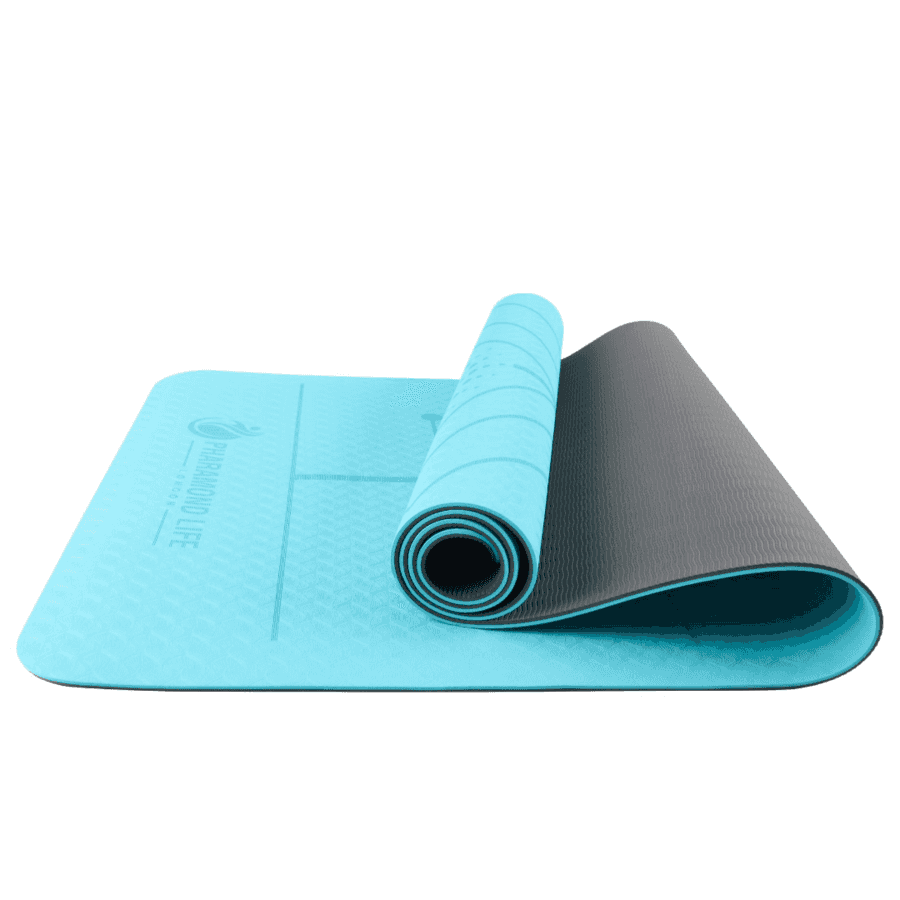
The yoga community is one that’s susceptible to hype when new products enter the market, and this is exactly what happened when the Pharamond Life Pro came onto the scene. But unlike some products, this one is sticking around for a good reason. It’s a solid mat – literally.
Its textured non-slip/skid bottom layer provides a ton of grip, so you won’t have to worry about slipping and sliding when you’re trying to move from Warrior II into Downward Dog.
There is a small sacrifice of sustainability here as its primary material is TPE, Pharamond Life Pro says it is 100% free of PVC, heavy metals, and other toxic materials. This eco-friendly yoga mat is also biodegradable.
At 6mm thick, this lightweight yoga mat is not short on cushion. It's also longer and wider than a standard yoga mat, giving you plenty of space to move and stretch.
It comes in an array of beautiful colors and is anti-microbial, waterproof, and odor-free.
- Size: 26” x 72”
- Thickness: 6mm
- Weight: just over 2 lbs
Currently on sale for $62!!
Best Extra-Thick Option: Jade Fusion Yoga Mat
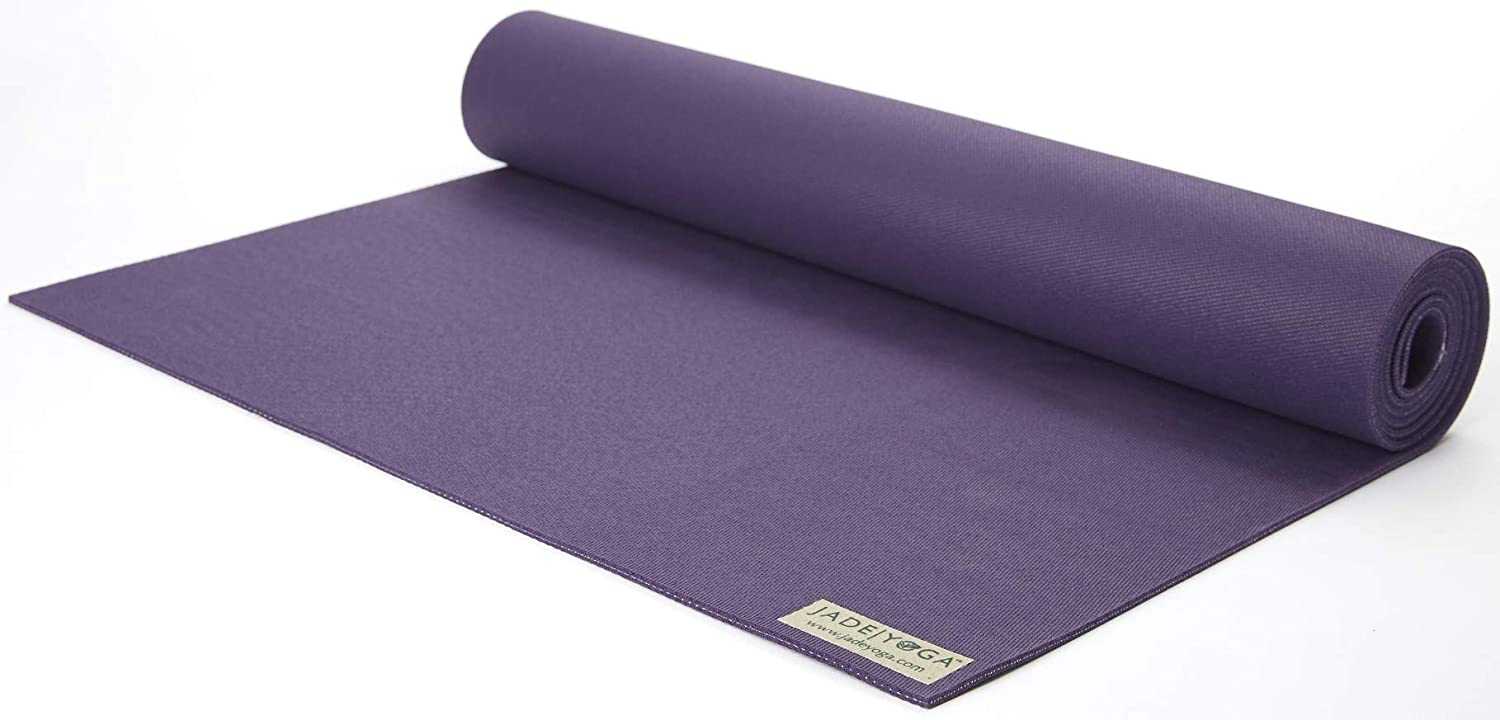
Natural yoga mats are wonderful, but they can be on the thinner side. This can then leave joints feeling strained in certain poses or cause discomfort in the hands, back, and knees. But the good news is some thicker sustainable options exist, like the Jade Fusion.
This extra thick mat is almost 8mm thick. It's supportive and endlessly comfortable.
Jade only uses natural rubber on their mats due to it's grippiness and cushion. No synthetic rubber is used in this yoga mat including PVC, PER, TPE, or EVA. Jade plants a tree for every mat sold, really pushing up the sustainability quotient. They have planted over one million trees since 2006.
To top it off, these mats are made in the United States. Not only does this provide Jade much more control over the materials and production processes used, it cuts down on global shipping pollution.
- Size: 24” x 68”
- Thickness: 7.95mm
- Weight: 7 lbs
Best for Travel: Manduka eKO Superlite Travel Mat

Keeping up with a solid yoga routine can be hard in the best of times. But when you’re busy and constantly traveling, it can seem downright impossible. Insert the Manduka eKO Superlight travel mat.
Exactly what’s advertised on the tin, it’s a mat that’s ultra-thin and portable at only two pounds and 1.5mm thick. That may not give you the motivation you need to stay consistent, but it certainly gives you one less excuse to slack off!
While maybe a little too thin for some, it makes up for it in its commitment to non-toxic construction and easy care. The eKO travel yoga mat is made from sustainably harvested natural tree rubber.
These eco-friendly yoga mats feature a rippled texture for improved traction. Their closed-cell surface prevents sweat from seeping into the mat, and their tight weave resists tearing or stretching. eKO claims that grip improves each time you use this non-toxic yoga mat.
- Size: 24” x 71”
- Thickness: 1.5mm
- Weight: 2.2 lbs
No matter which yoga mat (or none!) you choose, you are one step closer to attaining peace of mind and a more sustainable lifestyle.
